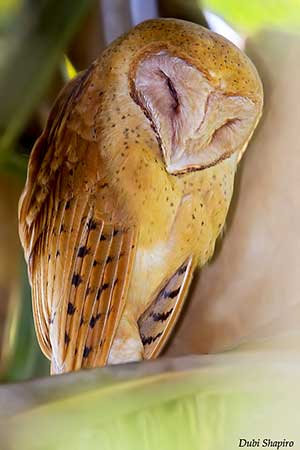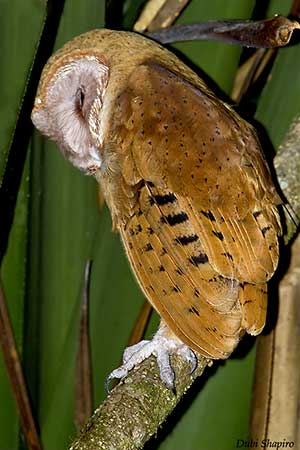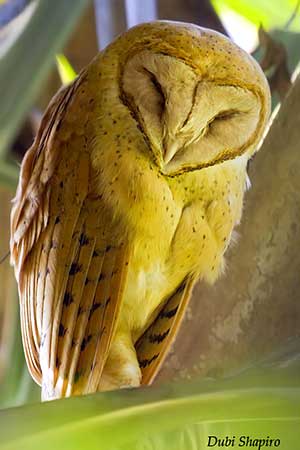
Fr: Effraie de Soumagne
Ang: Madagascar Red Owl
All: Malegasseneule
Esp: Lechuza Malgache
Ita: Barbagianni del Madagascar
Nd: Madagaskargrasuil
Sd: madagaskartornuggla
Photographer:
Dubi Shapiro
Dubi Shapiro Photo Galleries & Dubi Shapiro's Pictures on IBC
Text by Nicole Bouglouan
Sources :
HANDBOOK OF THE BIRDS OF THE WORLD Vol 5 by Josep del Hoyo-Andrew Elliott-Jordi Sargatal - Lynx Edicions - ISBN: 8487334253
OWLS OF THE WORLD – By Claus König, Friedhelm Weick and Jan-Hendrik Becking - IBSN 978-0-7136-6548-2
Owls of the World - A Photographic Guide: Second Edition – By Heimo Mikkola – Editeur: A&C Black, 2014 – ISBN: 147290592X, 9781472905925
The Birds of Africa: Volume VIII: The Malagasy Region: Madagascar, Seychelles, Comoros, Mascarenes - Par Roger Safford, Frank Hawkins – ISBN: 1408190494, 9781408190494- Editeur: A&C Black, 2013
Birds of Madagascar and the Indian Ocean Islands Par Roger Safford, Adrian Skerrett, Frank Hawkins – ISBN: 1472924118, 9781472924117- Editeur: Bloomsbury Publishing, 2015
Birds of the Indian Ocean Islands Par Ian Sinclair, Olivier Langrand - ISBN: 1868729567, 9781868729562- Editeur: Struik, 2003
Animal Diversity Web (University of Michigan Museum of Zoology)
Wikipedia, the free encyclopaedia
Ornithomedia - Le Web de l’Ornithologie
The Diet of the Madagascar Red Owl (Tyto soumagnei) on the Masoala Peninsula, Madagascar
Madagascar Red Owl
Tyto soumagnei
Strigiformes Order – Tytonidae Family
INTRODUCTION:
The Madagascar Red Owl is endemic to Madagascar where it frequents the undisturbed rainforest between 800 and 1,300 metres of elevation. It hunts along the forest edges and in ricefields. During the day, it roosts in small ravines among the foliage of various tree species. It is strictly nocturnal. It feeds on small rodents and insects, and typically nests in tree cavities or other natural holes.
The Madagascar Red Owl has restricted range in N and E Madagascar. It is threatened by deforestation that destroys its main evergreen forest habitat. Despite its presence in several protected areas, the small population is currently listed as Vulnerable.
DESCRIPTION OF THE BIRD:
Biometrics:
Length: 28-30 cm
Weight: 323-435 g
The Madagascar Red Owl has orange-rufous plumage overall. However, the upperparts are darker, mostly reddish-orange and finely spotted blackish-brown. On the upperwings, flight feathers are greater coverts are like the upperparts, but primaries, secondaries and outer tertials are narrowly barred black across the inner webs, except near the tips. The other wing-coverts are darker than upperparts and sparsely spotted with black. The tail is orange-rufous with narrow blackish bars on central rectrices.
The underparts are paler and more ochre than the upperparts, and finely spotted with black on breast and flanks. On the underwings, the coverts are cinnamon but the flight-feathers are paler than above.
The head lacks the ear-tufts. The facial disk is greyish-buff and heart-shaped. The rim is darker like the area around the eye.
The bill is pale grey. The eyes are blackish. On the legs, the tarsi are feathered greyish-buff and the bare toes are pale grey.
Male and female are similar.
The juvenile resembles adult with similar plumage and bare parts.

RANGE:
The Madagascar Red Owl lives in N and E Madagascar. Two sightings have been noted in 2002 in Kalambatritra Special Reserve in SC Madagascar. Other records in far N suggest that the species occurs at more sites, except in W of the island.
HABITAT:
The Madagascar Red Owl was usually associated with undisturbed rainforest, between 800 and 1,300 metres of elevation. But recent studies also indicate forest edges, ricefields and deforested areas by slash-and-burn where it often hunts.
During the day, it roosts in small ravines, along rock edges and cave entrances. It also roosts among tree foliage, perched at 3-7 metres above the ground.
CALLS AND SONGS: SOUNDS BY XENO-CANTO
The Madagascar Red Owl utters a loud, eerie, hissing screech of 1,5 seconds, a hair-raising “kcchhhhrrrrrrr” that descends abruptly at the end. This sound is repeated every 3-30 seconds and both mates call.
Other calls can be heard, described as “wok wok wok” followed by single, short, loud alarm call.
BEHAVIOUR IN THE WILD:
The Madagascar Red Owl feeds mainly (and typically) on small native mammals, usually rodents, except the introduced Rattus rattus. It also takes frogs and reptiles. It consumes invertebrates such as insects including cockroaches and grasshoppers and other species. The prey range from 12,8 to 78 grams.
The Madagascar Red Owl is strictly nocturnal and hunts by night. The hunting behaviour is poorly known, but from an observation of a long-term captive bird, it takes only live prey. It holds it with the talons and often removes and eats the head first, and then, the rest of the body. Pellets are regularly regurgitated. They are largely composed of bones.
The Madagascar Red Owl is usually found alone or in pairs. They return to the daytime roost about 30 minutes before sunrise. Both mates sometimes roost less than 30 metres apart, rarely together. They roost in densely vegetated forest edge habitat, perched at 3-7 metres above the ground.

The mating system of the Madagascar Red Owl is poorly known. Usually in Tytonidae, the male performs aerial displays while calling, and makes short flights over the nest-site. Courtship feeding by male to female may occur during the displays. They are probably monogamous, like the very similar Common Barn Owl (Tyto alba).
The Madagascar Red Owl is sedentary in Madagascar.
The flight is silent due to several special adaptations. The barn owls have a stiff, comb-like fringe at the leading edge of the flight-feathers, and mainly on the outer primaries, producing a laminar flow of air across the wing, that helps to reduce the noise.
REPRODUCTION OF THIS SPECIES:
The laying apparently occurs in late July/August, based on the observation of a one-week old young on September 12th.
Only one nest is described. It was placed in natural hole in tree, 23 metres above the ground. The isolated tree was 500 metres from the edge of the forest block. The nest floor was 120 centimetres below the entrance of the cavity. The floor was not lined, and only debris such as prey remains, droppings and decayed wood were found.
Two white downy chicks were in the nest, involving a clutch of at least two white eggs. The incubation is probably performed by the female, but the male provides her food during this period. The chicks are brooded by the female and fed by the male. Two weeks after hatching, the food is often placed directly inside the nest. One week later, the young receive the food outside the nest.
The female roosts in the cavity until 35 days after hatching. The young fledge at 63-70 days old, but they still depend on parents for several weeks, before to be independent at four months old.
PROTECTION / THREATS / STATUS:
The Madagascar Red Owl has restricted range. It is threatened by deforestation for agriculture expansion and commercial logging. The remaining habitat is threatened by the increasing human population.
The population is roughly estimated to number 3,500/15,000 individuals, and is suspected to be declining.
The Madagascar Red Owl is currently listed as Vulnerable.
